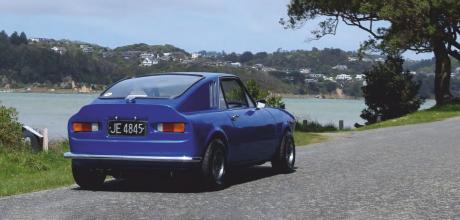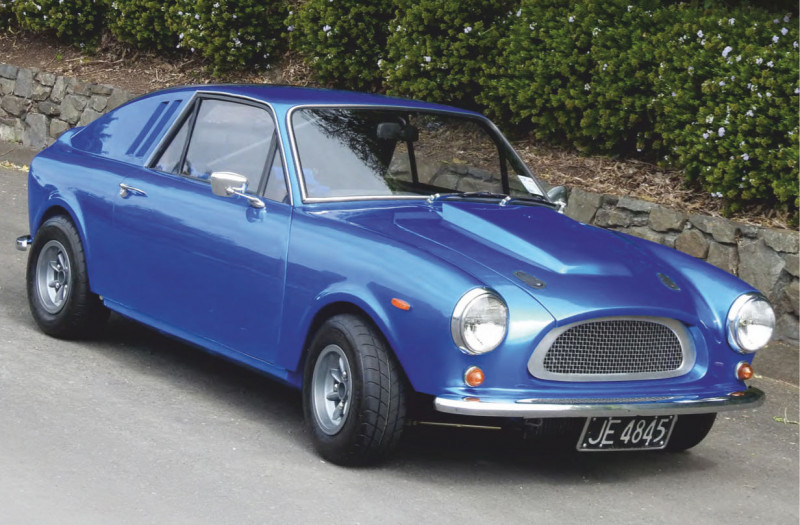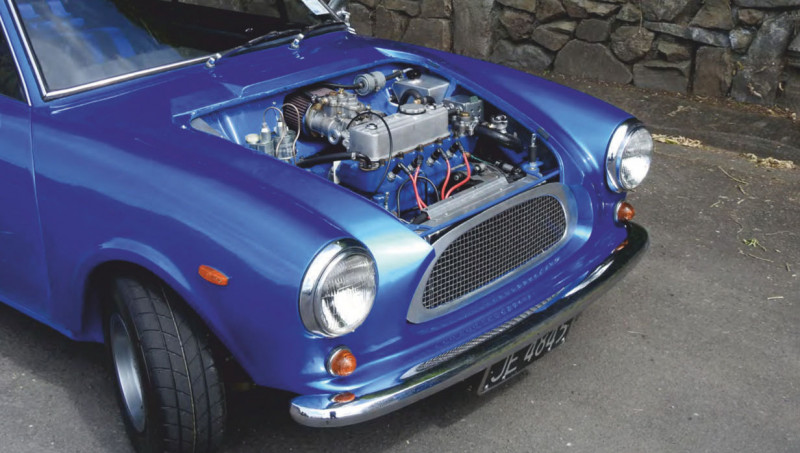1973 Ferris de Joux Mini GT

Looking and sounding far more exotic than the product of a double garage in Auckland, the Mini de Joux was the brainchild of one of New Zealand’s best automotive designers.
Words and photography by Patrick Harlow
PLAYING THE LONG GAME
Kits and Pieces
Ferris de Joux’s greatest hit
In 1973 Stephen, the owner of this featured Mini de Joux, went to a gravel hill-climb held at Hoopers Inlet on the Otago Peninsula. The event was won by John Rush driving a car he had never seen before, it was a de Joux GT, better known as the ‘Mini de Joux’. At the time he had no idea that it was a car designed and manufactured in New Zealand. Its handling and performance caught his attention, and he thought that one day he would like to own one.

The Mini de Joux first appeared in a 1965 edition of the Motorman magazine as a series of sketches and a clay mock-up. Early interest was high but potential buyers would have to wait until 1969 before the prototype rolled onto the road. It was based on one of the most popular cars of the day, the Leyland Mini, and took the ‘flying brick’ to a completely new level.
SIDELINE SPECIAL
At the time its creator, Ferris de Joux was working full time as a window dresser in Auckland. Car design was only ever a sideline hobby. The Mini de Joux was his fifth design and the car that would place him among New Zealand’s elite custom car creators. Believing he was on to something special in 1967, Ferris, with sketches for a Mini-derived sports car in hand, approached Seabrook Fowlds Ltd (1919–’69), the company importing and assembling Austins in Auckland. The manager saw the potential of the little GT coup. and wanted to put the car into production at the Dominion Motors plant, which was assembling the Mini in New Zealand. Conversations were carried out with Mini’s owner, the British Motor Corporation, which was to become ‘British Leyland’ the following year. While this was happening, Ferris approached Pilkington Glass in the Hutt valley about manufacturing a windscreen — Pilkington was manufacturing virtually all the windscreens and glass for New Zealand’s motor industry.

The stainless-steel mock-up that Ferris took with him was basically a cut-down version of the windscreen used in the Morris 1100. Believing it was on to a good thing Pilkington agreed to manufacture it.
The design of the de Joux GT was simple and ingenious. The Mini provided the floor pan, firewall, and drivetrain, which was strengthened in-house by Ferris and his team. On top of this they placed a fibreglass body shell that gave the Mini de Joux several advantages over its sibling. It was 230mm lower, 50mm wider, and 75mm longer. The fastback, together with a 25 per cent smaller frontal area, reduced the drag, improving its aerodynamics. The extra width gave it a more purposeful stance than its British counterpart, and it was 50kg lighter. Both less weight and better aerodynamics confer more speed.

The interior was upgraded too, the minimalist and cheap centre speedo being swapped out for a full sports instrument cluster placed in front of the driver. The absence of a rear seat saved more weight and took the car into the sports GT coup. territory.
‘WE ARE NOT AMUSED’
The clay mock-up was well underway when Ferris learned that the British Motor Corporation did not want anything to do with the car. This was a real setback but, having got so far, Ferris decided to press on and finish the cars himself. Apart from the windscreen, all other ‘glass’ was acrylic. This included the rear screen, which was non-opening. Owners who wished to stow any luggage could do it by flipping the front seats forward.
The bodies and doors were manufactured by Kestrene Plastics and shipped to a double garage that Ferris had leased in Penrose. Here, working mainly in the evenings, the fibreglass bodies were bonded to the pre-stiffened chassis and the entire car was then stiffened further with welded braces. Unlike the Mini, the de Joux had a specially made radiator fitted in front of the engine and behind a large mesh grille. The engine bay was made big enough to take a full-racespec Cooper 1.3-litre engine with a bonnet bulge that could house a couple of carburettors.
Most cars were sold as kitsets with the body and doors fitted to a rolling chassis. The kits could be bought for $500, about $9K in today’s money. A small number, however, were finished by Ferris and sold as turnkey cars. Most of them were built to be street legal although a few were built purely for the track.
By 1972, 20 cars had left his garage but by this time the creative side of Ferris was itching to move on to something else. He preferred designing cars to building them so he tried to sell the design as a complete package. He wrote to several kit-car companies in the UK thinking that its appeal would make similar sense in the Mini’s home country. He never got any replies.
THE END OF THE ROAD
The de Joux was permanently shelved, and Ferris moved on to designing and manufacturing boats full time, something he was even more passionate about. Cars would remain a sideline interest, however, and several more designs flowed from his capable hands over subsequent years.
Getting back to Stephen. He never forgot the time that he saw the Mini de Joux race to victory in Otago. In 1985 he saw a de Joux for sale in the Otago Daily Times. It was advertised as a ‘Leyland Mini sprint that needed work’. Stephen inspected and decided it needed a lot more work than for the money being asked warranted. He left his contact details with the owner but he didn’t expect to hear any more about it. Three months later the owner telephoned Stephen and told him he could have it for the amount Stephen had suggested. Stephen’s car had been sold by Ferris as a kit to a gentleman in Wellington. It is suspected that the original builder added the integrated rear spoiler lip and changed the bonnet slightly. It was quite common in those days, when building a car to make ‘improvements’, which also made it unique to the builder.
Stephen spent his first three months of ownership giving it a mechanical and cosmetic refresh before racing it for the first time at the Waitati Hill Climb in 1986. The lightweight car with its rubber-cone suspension performed faultlessly. Ross Cameron saw the car at Waitati and liked it too, so much so that he offered to swap a Terrapin for the GT. At the time Stephen was keen to hone his hill-climb skills and, as the Terrapin had been built by Kevin Ingram of Feilding, he knew that it would be more competitive than the de Joux, so he agreed to the swap.
It was a swap he regretted at length, feeling at the very least he had let it go too early. Ross Cameron kept the car for some time, using it as a daily driver and for speed events. He sold it to Michael Collins in Dunedin who fitted the Mini Cooper S front discs, along with a roll bar. Michael competed in the car but its 1380cc race motor suffered some damage. Current owner Stephen was still in touch with Ross and was pleasantly surprised to learn one day that Ross had bought the car back from Michael.
Ross repaired the engine and entered it in more events until eventually, in 1999, 13 years after Stephen had sold it, he parked it under a tarpaulin at the back of his shed. It would not move for another 20 years.
REUNITED
In 2018 Stephen met up with Ross again when he went to the South Island for a family birthday. Ross showed him his car collection, which actually contained three cars that Stephen had also owned previously. He informed Stephen that he had decided to reduce his car collection. “Now which one of these do you want to relieve me of?” he asked.
The de Joux has an innate appeal that has hardly diminished over time. It evokes an especially creative era in New Zealand’s car history and for Stephen it had the extra frisson of unfinished business that had called across the decades. There was really only one answer: the Mini de Joux.
And so, in 2019, Stephen once again owned the car he had regretted selling almost 35 years earlier. The GT was shipped back to the city of Wellington, where it had first been built up, and put into storage as a project for when he retired.
Stephen’s retirement occurred just in time for the first Covid lockdown in 2020. The number of restored cars that have emerged over the past couple of years suggests he was not alone in finding being ‘stuck at home’, an ideal opportunity to put in some quality time on particular projects.
As Stephen hopes to drive it competitively in the future, some parts such as the brakes were upgraded but the restoration that followed was intended, wherever possible, to keep it as original as possible. The engine, which was running when it arrived, has been left untouched with the exception of the head, now fully reworked to lift the compression ratio to 9.75:1.
RESTORED
Visually it remains close to its appearance when Stephen first owned it. The original Mini floor pan had some rust, so his good friend Scott Pearson of Pearson Fabrication was called on to do ‘a few small tasks’. Well, one thing led to another.
Scott took over the project, creating the car you see today. He is a genius at fabricating the small details that make this car special. The header tank, the catch tank, the battery box, and even the custom grille were all specially made by Scott and are works of art.
Dave Graham of Classic Panel & Paint took the finish to the next level. As you would expect from seeing the pictures, Stephen is exceptionally pleased with the final result.
As Stephen hopes to drive it competitively in the future, some parts such as the brakes were upgraded.
The integrated spoiler was probably added by the original builder.
Roll cage and full-harness seat belts necessary for some serious action.
And so, in 2019, Stephen once again owned the car he had regretted selling almost 35 years earlier
Stephen back on the road with the car he owned 35 years ago After the de Joux, Ferris ventured into boat design
The lightweight car with its rubbercone suspension performed faultlessly Stephen is exceptionally pleased with the final result
A different looking Mini de Juox when Stephen first owned it
Unlike the Mini, the de Joux had a specially made radiator fitted in front of the engine and behind a large mesh grille
A snug interior boasting a full set of gauges The full-race-spec Cooper 1.3-litre power plant offers more than enough power
Motorman magazine — The buck tacks shape in 1965
Stephen’s Mini de Joux ready for competitive action

